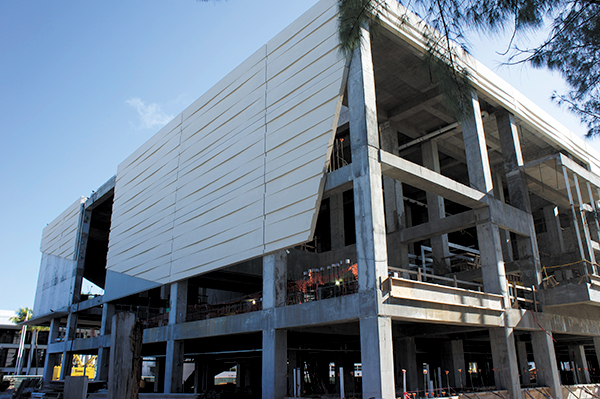
The Rosenstiel School of Marine and Atmospheric Science will be able to experience the hurricane season all year long.
RSMAS’s newest building, the Marine Technology and Life Sciences Seawater Complex, will feature the only existing complex to have the power to generate Category 5 hurricane winds. The complex is housed in the Surge Structure Atmosphere Interaction (SUSTAIN) research facility that focuses on the study of wind’s effects on land and sea.
“There’s things we can do in a lab to isolate different effects that you just can’t do in nature,” said Brian Haus, the principal investigator in the SUSTAIN component.
The ability to have these winds is an incredible advantage, according to graduate student Michelle Wilson who is studying meteorology. Recreating Category 5 winds will help forecasters prepare for these kinds of storms.
“This societal benefit is a big thing in hurricane research,” she said.
For Wilson, modeling the effects of storm surge from these winds will be just as important. Storm surge is the build-up of water that the storm drags until hitting the coastline. Storm surge was the primary reason for Sandy’s disastrous effects in the Northeast, especially New York City.
While existing marine science facilities, such as those of Pennsylvania State University and Oregon State University, are large-scale and sophisticated, these could only serve as general references, since they are completely different in their function. These current facilities lack SUSTAIN’s specialized wind component.
Though the structure of the building is complete, additional work must be done on the state-of-the-art interior. Six months remain in leading up to the scheduled September completion.
Other than RSMAS’s own smaller existing building, the project lacked a predecessor, meaning that the project required rigorous pre-testing and modeling to design a structure that could sustain such extreme forces.
Approximately one-third of the funds needed to realize the project, $15 million were awarded by the National Institute of Standards and Technology as part of the American Recovery and Reinvestment Act when RSMAS won a competition in late 2009.
With SUSTAIN, the new building will also have another facility called The Marine Life Sciences Center for the study of marine organisms.
With a space designed for housing and studying marine animals, such as fish and corals, the complex will allow for the observation of wild life in a controlled environment, where variables can be closely monitored. The building will focus mostly on research but will also be aimed at education and teaching.
While the facility is scientific in its function, its applications are multi-disciplinary. The overarching theme is that of understanding human interactions with nature whether it involves the wind or the sea.
Junior Abby Page believes that current scientific research needs to focus on this advancement.
“We’re learning that everything we’ve done has an impact,” she said. “You can’t study one without the other, humans and their environment.”
The building’s aesthetics suit these varied functions with easier access to the water.
“It will change the whole way the campus is laid out,” Haus said.





